Prison Postcards Part II
(Part I appeared in this publication March 2, 2022)
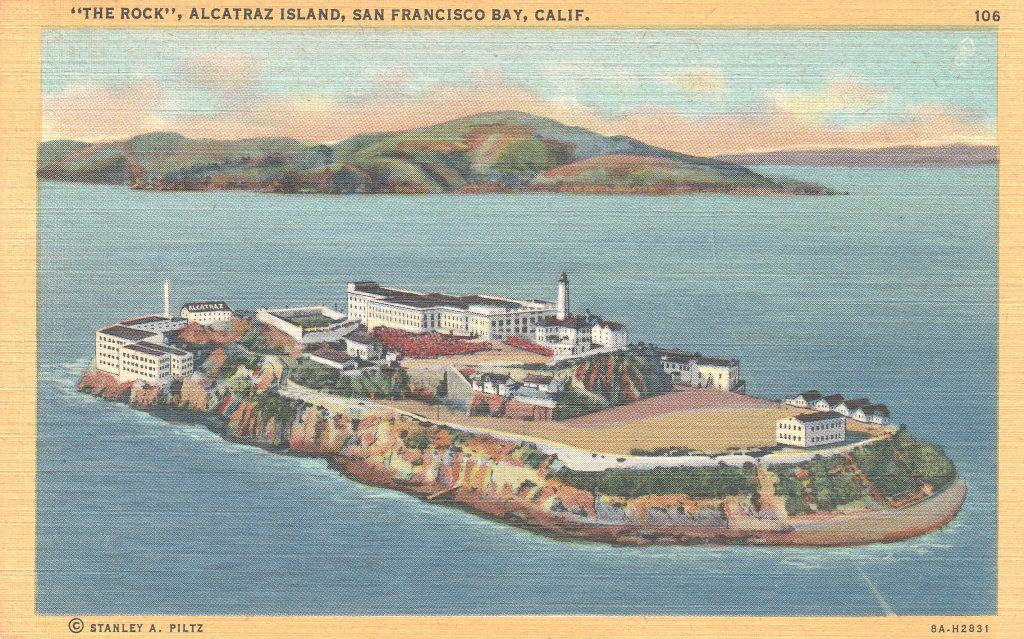
Alcatraz
No other prison has captured the public’s imagination like Alcatraz Island. Nicknamed The Rock, it is located at the center of San Francisco Bay about 1.25 miles offshore. The island covers about twenty-two acres. The first prison located on Alcatraz was a military prison during the Civil War. Federal officials determined the island was escape proof due to swift currents around the island and the cold temperatures of San Francisco Bay. Until the Spanish American War, only a handful of prisoners were incarcerated on the island, then in 1907, it was designated as the Western Military Prison. In 1933, the military turned it over to the Justice Department, and in August 1934, the first prisoners were transferred to Alcatraz. Over the years it housed many infamous criminals including Al Capone and Robert Franklin Stroud, known as the Birdman of Alcatraz. Burt Lancaster portrayed Stroud in the 1962 film, Birdman of Alcatraz.
The harsh surroundings did not stop attempts to escape. Two inmates are presumed to have drowned attempting to swim to shore in 1937 and their bodies swept out to sea by the currents. In 1962, an inmate swam to San Francisco, however he was unconscious and in hypothermic shock when rescued.
One escape was portrayed in Clint Eastwood’s 1979 film, Escape From Alcatraz. Three inmates, Frank Morris, and brothers John and Clarence Anglin, escaped on June 11, 1962. They made a raft from raincoats glued together in a prison workshop. Remnants of their makeshift raft washed up on shore and it was presumed they drowned. Their bodies were never recovered. The film’s ending implied that their escape may have succeeded.
The Federal Bureau of Prisons closed Alcatraz in March 1963 due to its high operating costs. Its buildings were crumbling due to the corrosive effects of sea water and salt air. Although designed to house 450 inmates, the population rarely exceeded 250 inmates.
Today Alcatraz is aa popular tourist attraction operated by the National Park Service and draws 1.5 million visitors annually.
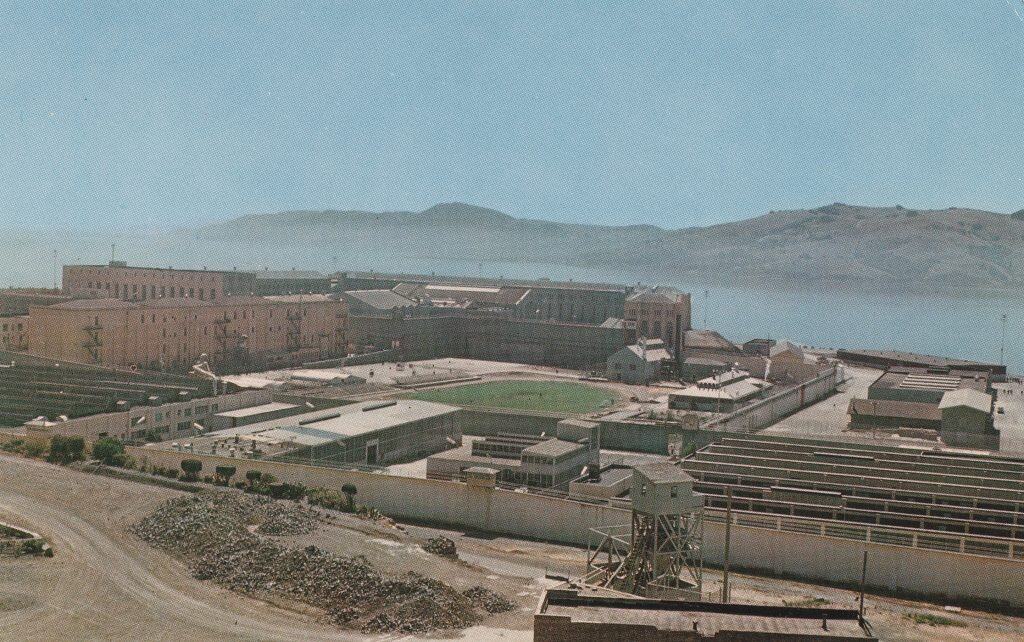
San Quentin
Opened in 1854, San Quentin is the oldest prison in California (now named the San Quentin Rehabilitation Center). Located on the northern side of San Francisco Bay, San Quentin occupies 275 acres of prime waterfront real estate. Its design capacity is 3,084 inmates but usually houses over 3,200 inmates. As a maximum security facility, over seven hundred inmates were on death row in 2015.
Since 1893, San Quentin has been the site of 422 executions by either hanging, lethal injection, or in a gas chamber. Of that number, 194 died in the prison’s green gas chamber. California last executed an inmate in 2006 and only seven since 1973. In 2019, California Governor Gavin Newsome declared a moratorium on executions and ordered the gas chamber dismantled. The 532 prisoners on death row will be transferred to other prisons and their sentences commuted to life in prison. California plans to complete the transfer by this (2024) summer. Currently, the oldest person on death row is ninety-three.
Country singer Merle Haggard began serving a fifteen year sentence at San Quentin in 1958. While incarcerated, Haggard, who was inmate “A45200,” attended a 1958 Johnny Cash concert at the prison. Already a guitar player in the prison’s country western band, Cash’s concert inspired Haggard to become a singer-songwriter if he was ever released. Haggard turned his life around and became a model inmate, winning parole in 1960. Governor Ronald Reagan later pardoned Haggard.
San Quentin, crumbling and in disrepair, will undergo a $360 million renovation to enable it to offer rehabilitation programs focused on preparing inmates for life after prison.
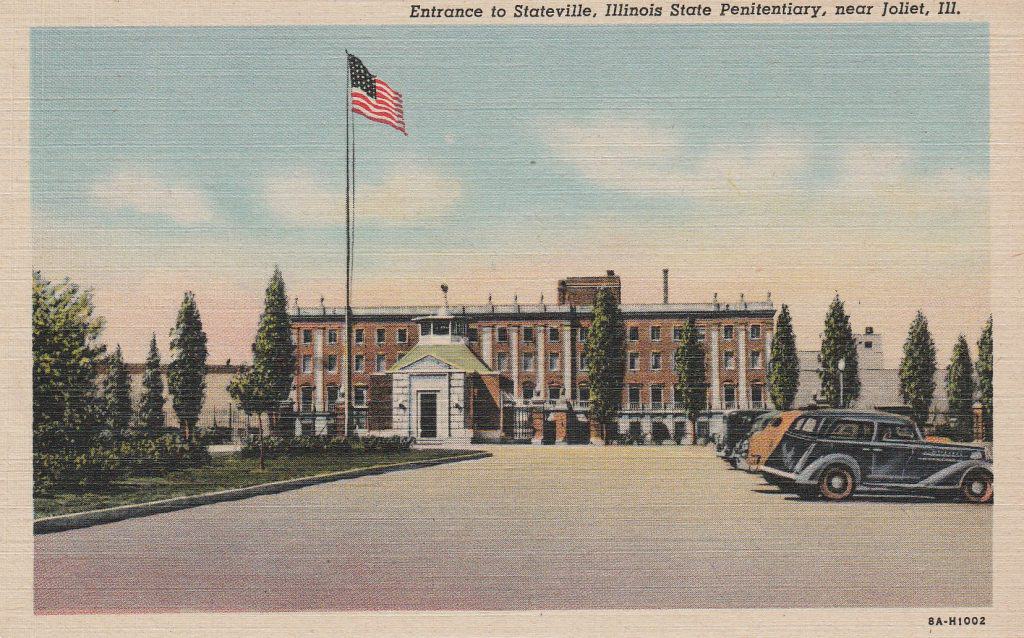
Stateville
The Illinois State Penitentiary is located in Crest Hill (now called the Stateville Correctional Center), this maximum security prison, opened in 1925 and was designed to hold 1,506 inmates. Its average capacity today is 3,500 inmates. Stateville is famous for its F-House cellblock, a rotunda of several tiers of cells with an armed tower in its center.
Known as a panopticon, the roundhouse was designed so that a guard could observe several cells at once without the inmates knowing who was being watched. In theory, the inmates functioned as if they were under constant surveillance and forced to maintain good behavior. The first panopticon prison, Millbank Prison in Great Britain, opened in 1822. Besides Great Britain, other panopticon prisons were built in the Netherlands and Cuba.
F-House was closed in 2016 but remains standing as a historic building. Stateville may close later this year under a plan by the Department of Corrections to rebuild it and another crumbling prison, but the plan is opposed by unions representing correctional employees and elected officials in the affected localities.
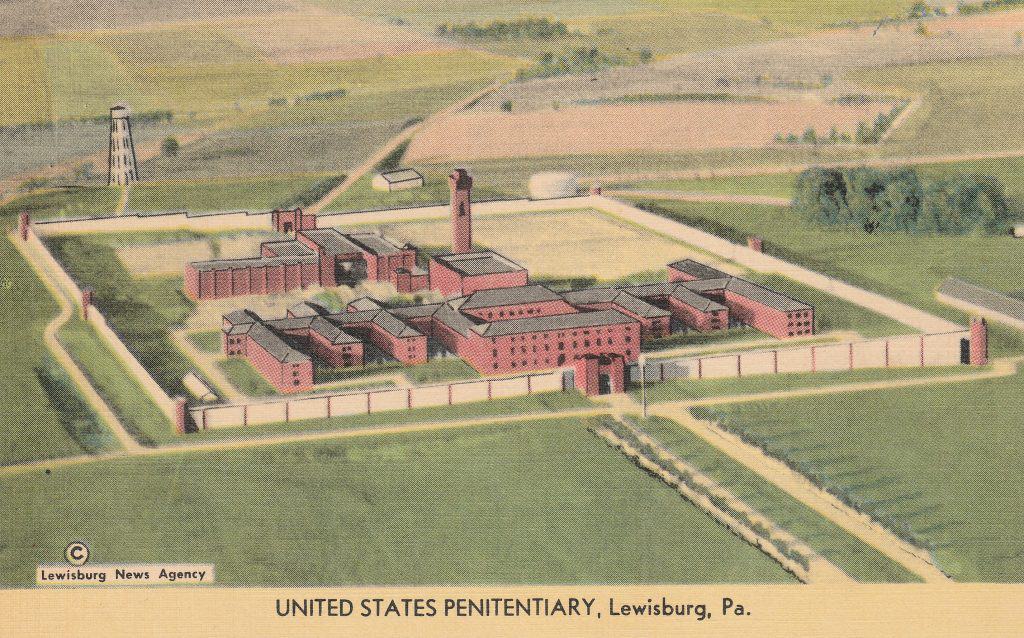
Lewisburg
Originally named the Eastern Penitentiary, the United States Penitentiary, Lewisburg (Pennsylvania) was one of five prisons opened by the Federal government in 1932. It was intended to house inmates convicted of federal crimes from Maine to Virginia.
The site was selected for its proximity to major cities like New York, Philadelphia, and Baltimore. Also, it had good railroad and highway access plus vast acreage for agricultural enterprises. Many prisons at the time had vast farms to grow food and provide work for the inmates.
Famed architect Alfred Hopkins (1870 – 1941), designed the initial building at Lewisburg. Inspired by the French Renaissance style, Hopkins was known for designing country estates for the wealthy like Frederick Vanderbilt and Joseph Medill McCormick. Behind the prison’s thick brick walls, buildings are adorned with gothic arches, terra cotta brick, and ornamental corbels. Inmates did not characterize Lewisburg as a country estate.
Currently it is a medium security prison, housing a total of 1,043 inmates, 687 inmates at the walled prison and 356 inmates at an adjacent minimum security prison camp for non-violent offenders. Currently it is one of 112 federal prisons. When it was completed, it was only the fourth federal prison for male offenders. Due to its proximity to New York City, many Mafia figures have been incarcerated there.
On Valentine’s Day in 1970, Lewisburg’s inhabitants were surprised to see an airplane towing a flowing banner over the town. The banner proclaimed, Happy Birthday, Jimmy! After it passed over the prison, residents realized the banner was intended for an inmate residing at Lewisburg, Jimmy Hoffa. Teamsters’ union leader Hoffa served time at Lewisburg from 1968 until 1971 for his conviction on jury tampering and fraud charges. President Nixon commuted Hoffa’s thirteen-year prison sentence in 1971.
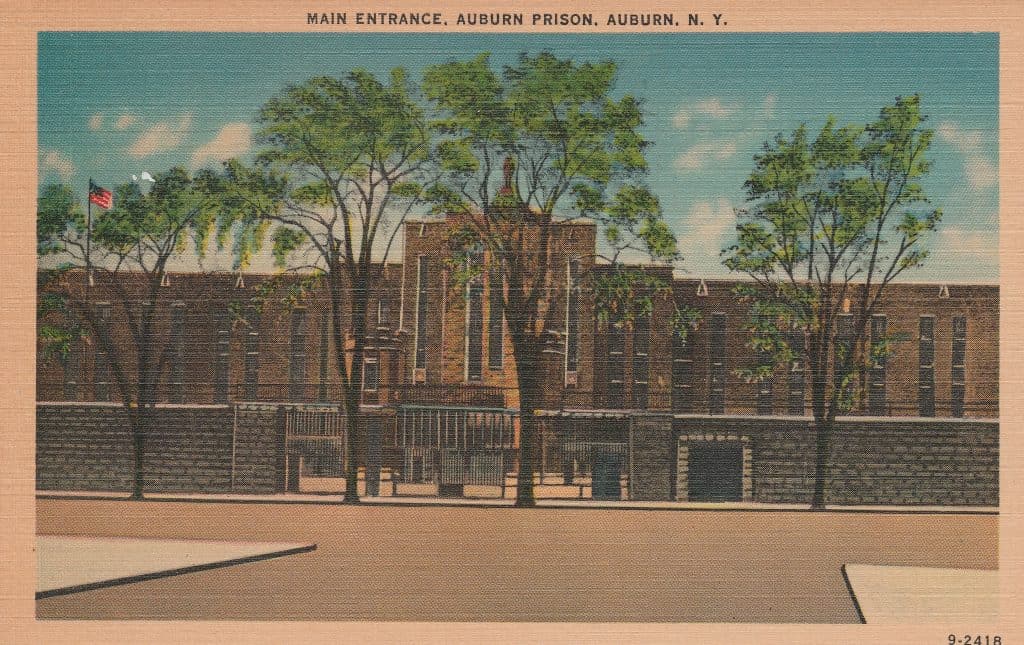
Auburn
The city of Auburn, New York, is home to the Auburn Correctional Facility. The second prison in New York State, Auburn, was built in 1816 and the first prisoners arrived in 1817. Much of the original prison was built by inmate labor. Construction on the current facility began in the early 20th century. Today it is a maximum-security institution, home to 1,800 prisoners and is one of the oldest prisons operating in the United States.
The construction of Auburn marked a shift in American prison practices from reforming the prisoner to punishing them. The word penitentiary was originally used to describe a place where penitents reflected upon their sins or transgressions against the law. The Quakers first used the term penitentiary in the 1790’s.
Auburn developed what later became known as the “Auburn System.” Prisoners were compelled to toil at hard labor in workshops on the prison grounds manufacturing a variety of products. The goal was to make the prison self-supporting.
The inmates were forbidden to communicate with their fellow prisoners during meals or work. At night, inmates were locked in individual cells. Corporal punishment was widely used to keep prisoners in line. Auburn first developed the prison uniform of horizontal black and white stripes. When moving around the prison, prisoners walked in lockstep with their heads bowed and their arms locked with the prisoner in front of them. By 1850, the Auburn System was adopted by all other states except for Pennsylvania. The Auburn System fell out of favor at the end of the 19th century.
The world’s first execution by electrocution occurred at Auburn Prison on August 6, 1890. William Kemmler had been sentenced to death for murdering his lover with an axe. It was believed that the electric chair would be a more humane method of execution than hanging. Leon Czolgosz, the assassin of President William McKinley, was executed at Auburn on October 29, 1901, just seven weeks after he shot McKinley.
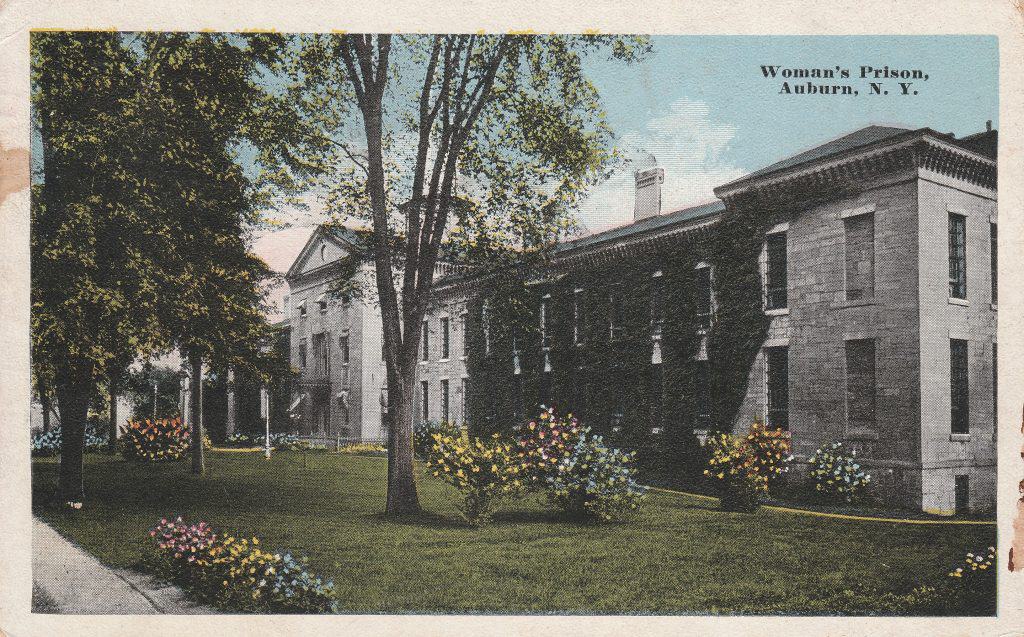
Women’s prisons get the short shrift compared to men’s prisons. I have over twenty prison postcards in my collection, but only one of a women’s prison. Women’s prisons do not have the infamy of men’s prisons. Sing Sing, Alcatraz, Folsom Prison, and San Quentin have been featured in motion pictures. Johnny Cash immortalized Folsom Prison in his 1955 song, Folsom Prison Blues.
A postcard mailed in July 1917 shows the Women’s Prison in Auburn, New York. With its ivy-covered walls and flowering shrubs, the prison could pass for a building at a women’s college. In 1894, when an asylum for the criminally insane was closed, the state authorized the buildings to be used as a women’s prison. Prior to that female prisoners lived in an attic above the kitchen at the men’s prison in Auburn and were fed only once a day.
The new prison had 125 rooms and could accommodate up to 250 female prisoners. Despite being convicted, usually of non-violent offenses, female prisoners were considered more trouble than male prisoners. Authorities deemed female prisoners beyond reformation since they had fallen from the pedestal of womanhood. Auburn Women’s Prison closed in 1933 and the inmates were transferred to the new women’s prison in Bedford Hills.
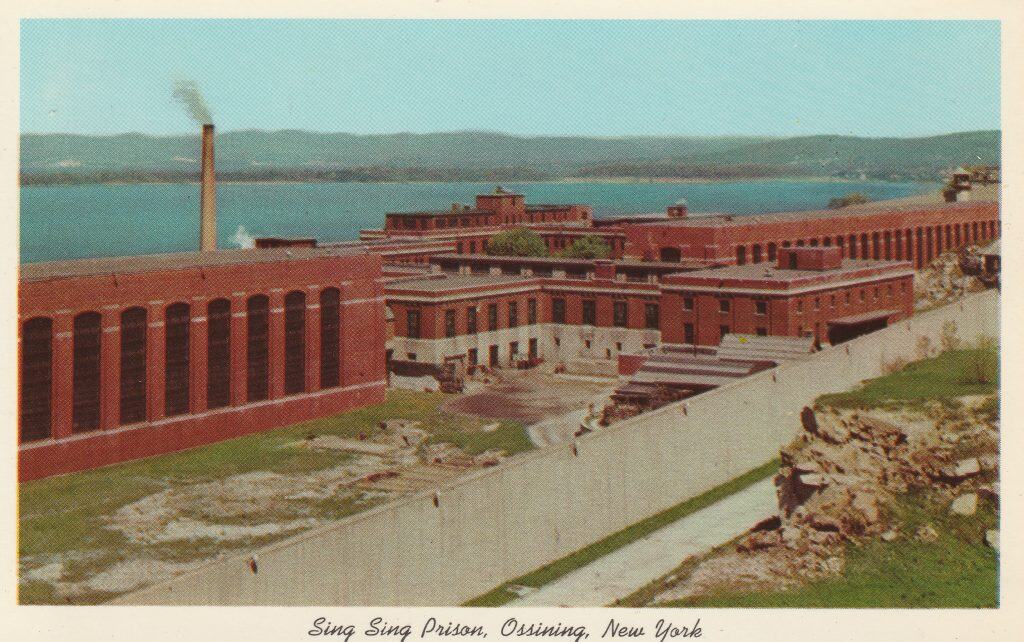
Sing Sing
The Sing Sing Correctional Facility in Ossining, New York, is a maximum security prison with a capacity of 1,700 inmates. Located in the Hudson River Valley, it is thirty miles north of midtown Manhattan. Built in the 1825, it is one of the oldest prisons in the United States. The current facility was constructed in the early 20th century.
Thanks to Hollywood films, Sing Sing achieved stardom among American prisons. The 1932 film 20,000 Years in Sing Sing starred Spencer Tracy as an inmate and Bette Davis as his girlfriend. James Cagney, Pat O’Brien, Humphrey Bogart, and the Dead End Kids starred in the 1938 film Angels with Dirty Faces. Cagney’s walk to the electric chair was filmed at Sing Sing’s Death House. The American Film Institute named it the 67th Best Film of All Time. James Cagney returned to Sing Sing in the 1939 film, Each Dawn I Die; George Raft co-starred with Cagney.
Sing Sing was the fifth prison constructed in New York State. One hundred prisoners from Auburn Prison were selected by Auburn’s Warden, Elam Lynds, to construct the new prison in the village of Sing Sing (renamed Ossining in 1901 to avoid the stigma associated with the prison). Work began in May 1825 and the inmates were housed in a temporary barracks. There was no wall to keep them from escaping. The site was selected because it was adjacent to a marble quarry that provided employment for the inmates and made the prison profitable.
The four-story 1825 cellblock initially had eight hundred cells that were seven feet long and three feet wide. Warden Lynds imposed the harsh Auburn System on the inmates. Two more stories were added later. Designed to hold a single inmate, the cells later housed two inmates. Nicknamed “the Big House” and “the Castle,” the 1825 cellblock is a crumbling ruin today.
Around 1891, Sing Sing’s location produced the prison slang “up the river” for going to prison since new inmates from New York City were transported by boat up the Hudson River to Sing Sing. Within a decade, it became a popular expression nationwide for being incarcerated.
A total of 614 inmates were executed in the electric chair at Sing Sing’s “Death House” between 1891 and 1963. Six women were among those executed. In 1924, Bessie Smith recorded Sing Sing Prison Blues, a lament from a woman who killed her man and wanted to be executed upon arrival at the prison.

The Roman Catholic Church of the Good Thief is located inside the maximum security Clinton Correctional Facility in Dannemora, New York. It is the only church in the United States constructed inside the walls of a prison. Constructed by the prison’s inmates between 1939 and 1941, it was built of fieldstones salvaged from 19th century structures inside the prison walls. Neogothic in design, the church measures 132 feet long by 52 feet wide. A 106 tall tower adjoins the church.
Father Ambrose Hyland, the prison’s chaplain, believed a church was needed when he arrived in 1937. At that time, Mass was celebrated in the prison’s auditorium. A convicted forger designed and constructed the stained-glass windows using inmates as models. Another inmate modeled for the statue of Saint Dismas on the cross that is installed over a side altar. Inmates also made the lamps that hang in the church. The pews were constructed by prisoners using Adirondack red oak donated by former Dannemora prisoner, gangster Lucky Luciano. Marble for the altar was donated by friends of Luciano.
The church is dedicated to the patron saint of the condemned, Saint Dismas, the Good Thief. He is also the patron of prison inmates and repentant thieves. Dismas was one of the two thieves crucified with Jesus. One mocked Jesus, saying “Are you not the Messiah? Save yourself and us.” Dismas rebuked the other thief, “Have you no fear of God, for you are subject to same condemnation?” Then Dismas said, “Jesus, remember me, when you come into your kingdom.” Jesus replied, “Amen, I say to you, today you will be with me in Paradise.” Dismas is considered the first saint and the only one canonized by Jesus.
Thanks for the history behind each card! I’ve collected prison postcards for 30+ years. One of my favorites shows inmates in the dining hall with a message reading, “Dear Mom – I sure do miss your cooking. Your son, John (with his prison ID number)”. I have just a handful of those specifically for Black or female inmates. Several years ago I met the infamous Sheriff Joe Arpaio, who gifted me with one of each of the 6 postcards they provided to inmates to use for correspondence, since the postage is cheaper than for letters. Hope this brings more collectors… Read more »
Thank you for a really interesting and informative article. I’ve lived close enough to a couple of prisons to drive by them frequently but it never even occurred to me that it would be a great topic to collect.
My great-grandfather was playing in the band at the Temple of Music when President McKinley was assassinated in Buffalo. It’s hard to believe that Leon Czolgosz was executed at Auburn less than two months after he fired the fatal shot — the wheels of justice turned much more quickly in those days!
Great article. Very interesting but probably seldom discussed topic. I have never come across these particular cards however at future shows I will look a little harder, Thanks.
I enjoyed this article. Although I was familiar with Alcatraz, I learned quite a bit about the other prisons described in the article. I was particularly interested in the information about the name change for Ossining, NY. I was under the impression that “Sing Sing” was a slang expression for Ossining. I don’t think the tactic of renaming the city was effective since I think most people make the connection between Ossining and Sing Sing. If you plan to complete another article on this topic, please consider including military prisons such as Leavenworth. I did detect an undercurrent of fascination… Read more »